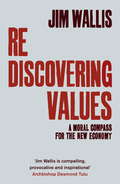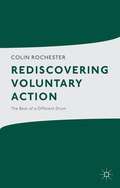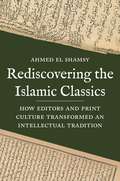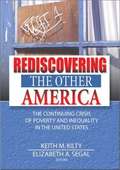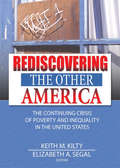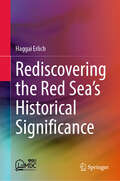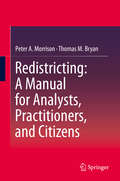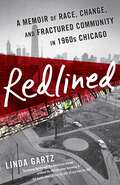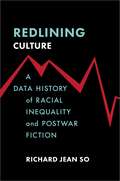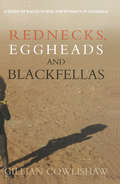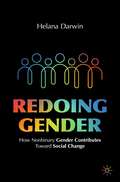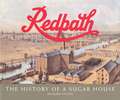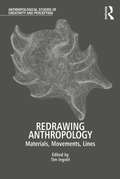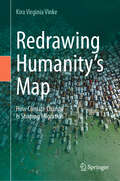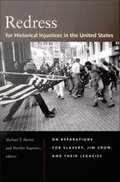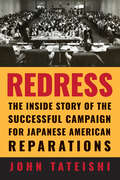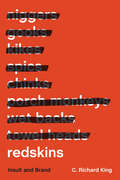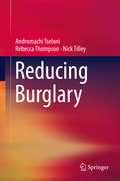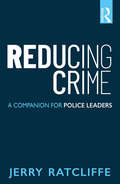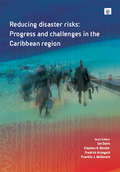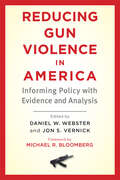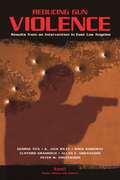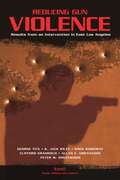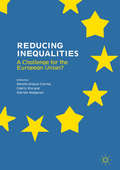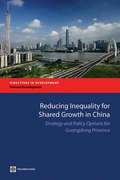- Table View
- List View
Rediscovering Values: A Moral Compass For the New Economy
by Jim WallisWhen we start with the wrong question, no matter how good an answer we get, it won't give us the result we want. Rather than asking, 'When will this economic crisis be over?' Jim Wallis says the right question to ask is 'How will this crisis change us?'. The worst thing we can do now, Wallis tells us, is to go back to normal. Normal is what got us into this situation. We need a new normal, and now, in the midst of a crisis affecting every part of society, is the time to discover it. These are some of the principles Wallis suggests we should consider-Spending money we don't have on things we don't need is a bad foundation for an economy or a family-It's time to stop keeping up with the Joneses and start making sure the Joneses are okay-The values of adverts and billboards are not the things we want to teach our children-Caring for the poor is not just a moral duty but is critical for the common good-A healthy society is a balanced society in which markets, the government, and our communities all play a role-The operating principle of God's economy says that there is enough if we share itIn REDISCOVERING VALUES, Wallis equips us with a new moral compass for the future -- one that draws on some of our oldest and best values and one that will guide us in the City, our towns and our neighbourhoods.
Rediscovering Voluntary Action
by Colin RochesterVolunteering and voluntary organizations have become increasingly important in British social and political life but at a cost. Greater prominence has led to a narrow and distorted view of what voluntary action involves and how it is undertaken. This book reasserts the case for a broader view of voluntarism as a unique set of autonomous activities.
Rediscovering the Islamic Classics: How Editors and Print Culture Transformed an Intellectual Tradition
by Ahmed El ShamsyThe story of how Arab editors of the late nineteenth and early twentieth centuries revolutionized Islamic literatureIslamic book culture dates back to late antiquity, when Muslim scholars began to write down their doctrines on parchment, papyrus, and paper and then to compose increasingly elaborate analyses of, and commentaries on, these ideas. Movable type was adopted in the Middle East only in the early nineteenth century, and it wasn't until the second half of the century that the first works of classical Islamic religious scholarship were printed there. But from that moment on, Ahmed El Shamsy reveals, the technology of print transformed Islamic scholarship and Arabic literature.In the first wide-ranging account of the effects of print and the publishing industry on Islamic scholarship, El Shamsy tells the fascinating story of how a small group of editors and intellectuals brought forgotten works of Islamic literature into print and defined what became the classical canon of Islamic thought. Through the lens of the literary culture of nineteenth- and twentieth-century Arab cities—especially Cairo, a hot spot of the nascent publishing business—he explores the contributions of these individuals, who included some of the most important thinkers of the time. Through their efforts to find and publish classical literature, El Shamsy shows, many nearly lost works were recovered, disseminated, and harnessed for agendas of linguistic, ethical, and religious reform.Bringing to light the agents and events of the Islamic print revolution, Rediscovering the Islamic Classics is an absorbing examination of the central role printing and its advocates played in the intellectual history of the modern Arab world.
Rediscovering the Other America
by Elizabeth A. Segal Keith M. KiltyLearn why it is imperative to bring a progressive focus back to social welfare policy! This vital book explores recent research on poverty and inequality, identifies strategies for ensuring adequate services, and challenges many of the inaccurate beliefs that were used to justify welfare reform legislation in 1996. You'll find up-to-date information on various marginalized groups and their social problems, including lack of health coverage for women with mental health, substance abuse, and domestic violence problems. In addition, you'll find data on the health coverage situation for the poor, for Appalachians, and for women in general. Finally, Rediscovering the Other America: The Continuing Crisis of Poverty and Inequality in the United States suggests strategies for changing public perceptions about the nature of poverty and the poor. From the editors: "In 1962, Michael Harrington published The Other America, which documented how deeply entrenched poverty and inequality were in one of the wealthiest countries in the world. Four decades later, we find it necessary once again to rediscover this profound social condition. The purpose of this book is to awaken policymakers and the public to this situation once again, in order to affect the nature of public policies dealing with these issues." Rediscovering the Other America: The Continuing Crisis of Poverty and Inequality in the United States covers a wide range of issues, some similar to what Harrington described in 1962 and some reflecting recent social, political, and economic developments.
Rediscovering the Other America: The Continuing Crisis of Poverty and Inequality in the United States
by Elizabeth Segal Keith KiltyLearn why it is imperative to bring a progressive focus back to social welfare policy! This vital book explores recent research on poverty and inequality, identifies strategies for ensuring adequate services, and challenges many of the inaccurate beliefs that were used to justify welfare reform legislation in 1996. You'll find up-to-date information on various marginalized groups and their social problems, including lack of health coverage for women with mental health, substance abuse, and domestic violence problems. In addition, you'll find data on the health coverage situation for the poor, for Appalachians, and for women in general. Finally, Rediscovering the Other America: The Continuing Crisis of Poverty and Inequality in the United States suggests strategies for changing public perceptions about the nature of poverty and the poor. From the editors: "In 1962, Michael Harrington published The Other America, which documented how deeply entrenched poverty and inequality were in one of the wealthiest countries in the world. Four decades later, we find it necessary once again to rediscover this profound social condition. The purpose of this book is to awaken policymakers and the public to this situation once again, in order to affect the nature of public policies dealing with these issues." Rediscovering the Other America: The Continuing Crisis of Poverty and Inequality in the United States covers a wide range of issues, some similar to what Harrington described in 1962 and some reflecting recent social, political, and economic developments. Specifically, the book addresses: providing health care coverage for the poor why poverty persisted during the economic boom of the Clinton presidency politicians' views and beliefs regarding poverty, welfare, and welfare recipients the impact of the 1996 welfare reform legislation on the nonprofit sector economic differences between women and men poverty in Appalachia the impact of welfare reform on those who receive public assistance
Rediscovering the Red Sea's Historical Significance
by Haggai ErlichThis volume is a comprehensive historical exploration of the Red Sea, a vital maritime route that connects the Mediterranean and the Indian Ocean. It highlights various pivotal moments and struggles from Aden to Suez, including the conflicts between Islamic powers and European imperialism over the route to India, ultimately leading to Western domination of the oceans. It highlights that the sea remains a theater of global strategy and a site of international trade and security struggles. The book integrates and summarizes relevant studies on the Arab Middle East, Ethiopia, and the Horn of Africa. From biblical times and the medieval struggles for global dominance to the current era of intense international competition along the maritime corridor known as the "Silk Road," it explores this enigmatic waterway. The book illuminates the significance and future importance of the sea's history. It is essential for all researchers interested in maritime borders and Ethiopian and Arab history.
Redistricting: A Manual for Analysts, Practitioners, and Citizens
by Peter A. Morrison Thomas M. BryanThis comprehensive manual provides a user-oriented overview of U.S. Census data and demographic methods for redistricting applications. It addresses current issues and concerns accompanying the creation, adjustment, and evaluation of election districts and plans that incorporate them using 2020 Federal Census data. It meets the needs of local governments, citizen redistricting commissions, parties to litigation, and practitioners using Census data for political redistricting. The book provides many examples of technical problems that analysts will encounter when applying these data, supplemented by extensive case studies illustrating these technical issues and how they can be addressed. The book is a source to consult for insight, background, and concrete examples of specific issues and concerns and how to address them. As such this comprehensive reference manual is a "must have" for applied demographers, data scientists, statisticians, citizen redistricting commissions, parties to litigation, practitioners, and any analyst or organization engaged in political redistricting using US decennial census data.Prepublication quotes:“As a litigator who advises local governments on redistricting matters, this book is an essential resource.” John A. Safarli, Partner, Floyd, Pflueger & Ringer, P.S., Seattle, WA “A valuable primer for those who will participate in redistricting. Provides those new to the highly-charged work of drawing districts an understanding of what is at stake, what options exist and the pitfalls to avoid.” Professor Charles S. Bullock, III, University of Georgia (author of Redistricting: The Most Political Activity in America) “A meticulously researched, well-structured and informative foray into the nuts and bolts of the redistricting process. . .Will aid the bench and bar, public officials, and those elected and appointed citizens who are entrusted with the heavy responsibilities of redistricting from start to finish.Lives up to its name as a pragmatic guide for those involved in the redistricting process, be they demographic experts, statistical analysts, election law attorneys, litigants, or citizens involved in redistricting commissions. A resource for teaching election law and for defending governmental entities ensnared in the redistricting process.A must for anyone engaged in political redistricting based on the 2020 U.S. Census data.” Benjamin E. Griffith, Adjunct Professor of Election Law, University of Mississippi, Robert C. Khayat School of Law, and Principal in Griffith Law Firm, Oxford, Mississippi. (Editor and Author of America Votes! Challenges to Modern Election Law and Voting Rights, ABA Section of State & Local Government Law, 4th Ed., December 2019)
Redlined: A Memoir of Race, Change, and Fractured Community in 1960s Chicago
by Linda GartzSet against the backdrop of the Civil Rights Movement, Redlined exposes the racist lending rules that refuse mortgages to anyone in areas with even one black resident. As blacks move deeper into Chicago&’s West Side during the 1960s, whites flee by the thousands. But Linda Gartz&’s parents, Fred and Lil choose to stay in their integrating neighborhood, overcoming previous prejudices as they meet and form friendships with their African American neighbors. The community sinks into increasing poverty and crime after two race riots destroy its once vibrant business district, but Fred and Lil continue to nurture their three apartment buildings and tenants for the next twenty years in a devastated landscape—even as their own relationship cracks and withers. After her parents&’ deaths, Gartz discovers long-hidden letters, diaries, documents, and photos stashed in the attic of her former home. Determined to learn what forces shattered her parents&’ marriage and undermined her community, she searches through the family archives and immerses herself in books on racial change in American neighborhoods. Told through the lens of Gartz&’s discoveries of the personal and political, Redlined delivers a riveting story of a community fractured by racial turmoil, an unraveling and conflicted marriage, a daughter&’s fight for sexual independence, and an up-close, intimate view of the racial and social upheavals of the 1960s.
Redlining Culture: A Data History of Racial Inequality and Postwar Fiction
by Richard Jean SoThe canon of postwar American fiction has changed over the past few decades to include far more writers of color. It would appear that we are making progress—recovering marginalized voices and including those who were for far too long ignored. However, is this celebratory narrative borne out in the data?Richard Jean So draws on big data, literary history, and close readings to offer an unprecedented analysis of racial inequality in American publishing that reveals the persistence of an extreme bias toward white authors. In fact, a defining feature of the publishing industry is its vast whiteness, which has denied nonwhite authors, especially black writers, the coveted resources of publishing, reviews, prizes, and sales, with profound effects on the language, form, and content of the postwar novel. Rather than seeing the postwar period as the era of multiculturalism, So argues that we should understand it as the invention of a new form of racial inequality—one that continues to shape the arts and literature today.Interweaving data analysis of large-scale patterns with a consideration of Toni Morrison’s career as an editor at Random House and readings of individual works by Octavia Butler, Henry Dumas, Amy Tan, and others, So develops a form of criticism that brings together qualitative and quantitative approaches to the study of literature. A vital and provocative work for American literary studies, critical race studies, and the digital humanities, Redlining Culture shows the importance of data and computational methods for understanding and challenging racial inequality.
Rednecks, Eggheads and Blackfellas: A study of racial power and intimacy in Australia
by Gillian CowlishawThis lively book brings the reader close to the people from a remote cattle station in far north Australia, where black and white peoples' lives have been intertwined over the span of 80 years. Tracing the humorous, savage and ordinary ways in which race structured intimate and everyday relationships across a great divide, Gillian Cowlishaw makes startling and original arguments about race relations.By investigating specific patterns of interaction on Australia's cultural frontier, Rednecks, Eggheads and Blackfellas illustrates how anthropologists, pastoralists and government officials squabbled about Aborigines as they intruded into their country, controlled aspects of their lives, and dominated the way they were represented in the public realm. The ironic title hints that the difference between 'redneck' pastoralists and 'egghead' anthropologists is not so great as might be imagined. Aborigines were central to the projects of both kinds of whitefellas.Weaving the shifts in government policy and public opinion with accounts of their sometimes ludicrous impact on outback communities, this book brings to life the complexities of living with racial categories. And it asks why increasingly enlightened anti-racist policies seldom seem to have worked as intended, even in this era of self-determination.This thought provoking work will speak not only to anthropologists and those interested in Aboriginal Australia, but to scholars of race more generally, especially in the burgeoning field of whiteness studies.
Redoing Gender: How Nonbinary Gender Contributes Toward Social Change
by Helana DarwinRedoing Gender demonstrates how difficult it is to be anything other than a man or a woman in a society that selectively acknowledges those two genders. Gender nonbinary people—who identify as other genders besides simply “man” or “woman”—have begun to disrupt this binary system, but the limited progress they have made has required significant everyday labor. Through interviews with 47 nonbinary people, this book offers rich description of these forms of labor, including “rethinking sex and gender,” “resignifying gender,” “redoing relationships,” and “resisting erasure.” The final chapter interrogates the lasting impact of this labor through follow-up interviews with participants four years later. Although nonbinary people are finally managing to achieve some recognition, it is clear that this change has not happened without a fight that continues to this day. The diverse experiences of nonbinary people in this book will help cisgender people relate to gender minorities with more compassion, and may also appeal to those questioning their own gender. This text will also be of keen interest to academics across Sociology and Gender Studies.
Redpath
by Richard FeltoeRedpath, today a household name for sugar in Canada, has its roots in the story of an enterprising Scots immigrant, initially a stone mason and later a building contractor during the boom days of Montreal’s growth from a small provincial centre to a major North American city. <P><P>In 1854, the ever-energetic John Redpath, by then a self-made millionaire in his late fifties, launched a new career as an industrialist. With his son, Peter, and the gifted George Alexander Drummond as manager, he established Canada’s first successful sugar refinery. <P><P>The Redpath story encompasses the influence of sugar as an economic force, the emergence of the elegant social life of cosmopolitan Montreal and a hind-sight view of the complexities of the love-hate relationship between government and business. <P><P>This, the first of two volumes, moves through Canada’s period of extensive industrialization to the turn of the century, the impact of World War I and concludes in the post-war years. Throughout this period, the familiar Redpath trademark, a reproduction of John Redpath’s signature, is a reminder of the heritage inherent in Canada’s business and social history.
Redrawing Anthropology: Materials, Movements, Lines (Anthropological Studies of Creativity and Perception)
by Tim IngoldWhy should anthropologists draw? The answer proposed in this groundbreaking volume is that drawing uniquely brings together ways of making, observing and describing. In twelve chapters, a team of authors from the UK, Europe, North America and Australia explore the potential of a graphic anthropology to change the way we think about creativity and perception, to grasp the dynamics of improvisatory practice, and to refocus the study of material culture from ready-made objects onto the flows of materials involved in the generation of things. Drawing on expertise in fields ranging from craftwork, martial arts, and dance to observational cinema and experimental film, they ask what it means to follow materials, to learn movements and to draw lines. Along the way, they contribute to key debates on what happens in making, the relation between design and performance, how people acquire bodily skills, the place of movement in human self-awareness, the relation between walking and imagination, and the perception of time. This book will appeal not just to social, cultural and visual anthropologists but to archaeologists and students of material culture, as well as to scholars across the arts, humanities and social sciences with interests in perception, creativity and material culture.
Redrawing Humanity’s Map: How Climate Change Is Shaping Migration
by Kira Virginia VinkeClimate shocks are shaping human geographies, threatening coastlines, flooding settlements and heating up cities. Therefore, climate impacts and the associated environmental changes are increasingly reflected in social systems. Based on eight years of research, this book sheds light on the impact of climate extremes on migration and displacement. It provides insights into the different contexts in which people experience the effects of climate change and how they shape migration decisions. In the absence of a supranational governance framework, individuals and institutions are already searching for sustainable solutions across the migration cycle to uplift communities. This book builds on qualitative interviews and focus group discussions in numerous countries with people who had to leave their ancestral homelands due to climate impacts, with groups trying to support them, and also with those who want to prevent migration. These exchanges produced not only a body of scientific work, but also a complex overall picture and personal impressions of the state of our planet and the people who live on it. &“Kira Vinke's pioneering work on climate migration sheds light on the darkness in which millions of people are fighting for their own survival.&” Prof. Dr. Dr. h.c. mult. Hans Joachim Schellnhuber, Director General, International Institute for Applied Systems Analysis &“Kira Vinke&’s work is an eye-opening testimony to the impacts of the climate crisis on migration and displacement. Her rigorously researched book combines narrations of displacement experiences around the world with hard facts. Despite all the challenges, it offers hope and highlights the urgency to act now.&” Andrew Harper, Special Advisor on Climate Action to the High Commissioner for Refugees, UNHCR
Redress for Historical Injustices in the United States: On Reparations for Slavery, Jim Crow, and Their Legacies
by Michael T. Martin Marilyn YaquintoAn exceptional resource, this comprehensive reader brings together primary and secondary documents related to efforts to redress historical wrongs against African Americans. These varied efforts are often grouped together under the rubric "reparations movement," and they are united in their goal of "repairing" the injustices that have followed from the long history of slavery and Jim Crow. Yet, as this collection reveals, there is a broad range of opinions as to the form that repair might take. Some advocates of redress call for apologies; others for official acknowledgment of wrongdoing; and still others for more tangible reparations: monetary compensation, government investment in disenfranchised communities, the restitution of lost property and rights, and repatriation. Written by activists and scholars of law, political science, African American studies, philosophy, economics, and history, the twenty-six essays include both previously published articles and pieces written specifically for this volume. Essays theorize the historical and legal bases of claims for redress; examine the history, strengths, and limitations of the reparations movement; and explore its relation to human rights and social justice movements in the United States and abroad. Other essays evaluate the movement's primary strategies: legislation, litigation, and mobilization. While all of the contributors support the campaign for redress in one way or another, some of them engage with arguments against reparations. Among the fifty-three primary documents included in the volume are federal, state, and municipal acts and resolutions; declarations and statements from organizations including the Black Panther Party and the NAACP; legal briefs and opinions; and findings and directives related to the provision of redress, from the Oklahoma Commission to Study the Tulsa Race Riot of 1921 to the mandate for the Greensboro Truth and Reconciliation Commission. Redress for Historical Injustices in the United States is a thorough assessment of the past, present, and future of the modern reparations movement. Contributors. Richard F. America, Sam Anderson, Martha Biondi, Boris L. Bittker, James Bolner, Roy L. Brooks, Michael K. Brown, Robert S. Browne, Martin Carnoy, Chiquita Collins, J. Angelo Corlett, Elliott Currie, William A. Darity, Jr. , Adrienne Davis, Michael C. Dawson, Troy Duster, Dania Frank, Robert Fullinwider, Charles P. Henry, Gerald C. Horne, Robert Johnson, Jr. , Robin D. G. Kelley, Jeffrey R. Kerr-Ritchie, Theodore Kornweibel, Jr. , David Lyons, Michael T. Martin, Douglas S. Massey , Muntu Matsimela , C. J. Munford, Yusuf Nuruddin, Charles J. Ogletree Jr. , Melvin L. Oliver, David B. Oppenheimer, Rovana Popoff, Thomas M. Shapiro, Marjorie M. Shultz, Alan Singer, David Wellman, David R. Williams, Eric K. Yamamoto, Marilyn Yaquinto
Redress: The Inside Story of the Successful Campaign for Japanese American Reparations
by John TateishiThe unlikely but true story of the Japanese American Citizens League's fight for an official government apology and compensation for the imprisonment of more than 100,000 Japanese Americans during World War II. Author John Tateishi, himself the leader of the JACL Redress Committee for many years, is first to admit that the task was herculean in scale. The campaign was seeking an unprecedented admission of wrongdoing from Congress. It depended on a unified effort but began with an acutely divided community: for many, the shame of "camp" was so deep that they could not even speak of it; money was a taboo subject; the question of the value of liberty was insulting. Besides internal discord, the American public was largely unaware that there had been concentration camps on US soil, and Tateishi knew that concessions from Congress would come only with mass education about the government's civil rights violations.Beyond the backroom politicking and verbal fisticuffs that make this book a swashbuckling read, Redress is the story of a community reckoning with what it means to be both culturally Japanese and American citizens; how to restore honor; and what duty it has to protect such harms from happening again. This book has powerful implications as the idea of reparations shapes our national conversation.
Redskins: Insult and Brand
by C. Richard KingThe Washington Redskins franchise remains one of the most valuable in professional sports, in part because of its easily recognizable, popular, and profitable brand. And yet “redskins” is a derogatory name for American Indians. The number of grassroots campaigns to change the name has risen in recent years despite the current team owner’s assertion that the team will never do so. Franchise owners counter criticism by arguing that the team name is positive and a term of respect and honor that many American Indians embrace. The NFL, for its part, actively defends the name and supports it in court. Prominent journalists, politicians, and former players have publicly spoken out against the use of “Redskins” as the name of the team. Sportscaster Bob Costas denounced the name as a racial slur during a halftime show in 2013. U.S. Representative Betty McCollum marched outside the stadium with other protesters––among them former Minnesota Vikings player Joey Browner––urging that the name be changed.Redskins: Insult and Brand examines how the ongoing struggle over the team name raises important questions about how white Americans perceive American Indians, about the cultural power of consumer brands, and about continuing obstacles to inclusion and equality. C. Richard King examines the history of the team’s name, the evolution of the term “redskin,” and the various ways in which people both support and oppose its use today. King’s hard-hitting approach to the team’s logo and mascot exposes the disturbing history of a moniker’s association with the NFL—a multibillion-dollar entity that accepts public funds—as well as popular attitudes toward Native Americans today.
Reducing Burglary
by Andromachi Tseloni Nick Tilley Rebecca ThompsonDomestic burglary has fallen significantly over the past 20 years in many countries, but still remains a high volume crime. On top of substantial financial loss and property damage, burglary also leads to high levels of anxiety and fear of crime. The research presented in this book represents the first systematic study of what actually works in security interventions against burglary, with cross-sectional data on different regions and socio-economic population groups. This work provides an overview of the scope of the problem and what can be done about it, drawing on extensive research evidence from projects funded by the Economic and Social Research Council (ESRC) Secondary Data Analysis Initiative (SDAI), and other sources. It reports detailed findings about which interventions are most effective for different population groups and how these measures can be implemented. It includes burglary prevention advice for homeowners, law enforcement and other public agencies, and makes recommendations for future research.In addition to being relevant to concerned citizens, police, policy-makers and crime prevention practitioners, this book will also be of interest to researchers in criminology and criminal justice, particularly those working on security and crime prevention, as well as urban planning and public policy.
Reducing Crime: A Companion for Police Leaders
by Jerry RatcliffeHow do I reduce crime in my police command? How do I tackle chronic crime problems? How do I address the long-term issues that have plagued my community? How do I analyze crime and criminal behaviour? How do I show evidence of success in crime reduction? What works, what doesn’t, and how do we know? Providing answers to these questions and more, this engaging and accessible book offers a foundation for leadership in modern policing. Blending concepts from crime science, environmental criminology, and the latest research in evidence-based policing, the book draws on examples from around the world to cover a range of issues such as: how to analyze crime problems and what questions to ask, why the PANDA model is your key to crime reduction, key features of criminal behavior relevant to police commanders, the current research on what works in police crime prevention, why to set up systems to avoid surprises and monitor crime patterns, how to develop evidence of your effectiveness, forming a crime reduction plan, tracking progress, and finally, how to make a wider contribution to the policing field. Crammed with useful tips, checklists and advice including first-person perspectives from police practitioners, case studies and chapter summaries, this book is essential reading both for police professionals taking leadership courses and promotion exams, and for students engaged with police administration and community safety.
Reducing Disaster Risks: Progress and Challenges in the Caribbean Region (Environmental Hazards Series)
by Ian Davis, Stephen O. Bender, Fredrick Krimgold and Franklin J. McDonaldAre we winning or losing the battle for safe environments? In 1984, leading disaster risk management professionals and researchers met in Jamaica for the Ocho Rios conference on Disaster Mitigation. In this collection, key experts reflect on the progress made in disaster risk reduction since that conference, with a particular emphasis on the Caribbean. Areas of focus include: trends in disaster risk management the links between disaster risk management and development the development of community based actions the efficacy of regulations to achieve safety the evolution of risk management institutions. The resulting volume provides a comprehensive overview of progress in the field and will be of interest to all those involved in disaster risk management and development.
Reducing Gun Violence in America: Informing Policy with Evidence and Analysis
by Daniel W. Webster and Jon S. VernickOutstanding Academic Title, Choice MagazineThe staggering toll of gun violence—which claims 31,000 U.S. lives each year—is an urgent public health issue that demands an effective evidence-based policy response.The Johns Hopkins University convened more than 20 of the world's leading experts on gun violence and policy to summarize relevant research and recommend policies that are both constitutional and have broad public support. Collected for the first time in one volume, this reliable, empirical research and legal analysis will help lawmakers, opinion leaders, and concerned citizens identify policy changes to address mass shootings, along with the less-publicized gun violence that takes an average of 80 lives every day.Selected recommendations include:• Background checks: Establish a universal background check system for all persons purchasing a firearm from any seller. • High-risk individuals: Expand the set of conditions that disqualify an individual from legally purchasing a firearm. • Mental health: Focus federal restrictions on gun purchases by persons with serious mental illness on the dangerousness of the individual.• Trafficking and dealer licensing: Appoint a permanent director to ATF and provide the agency with the authority to develop a range of sanctions for gun dealers who violate gun sales or other laws. • Personalized guns: Provide financial incentives to states to mandate childproof or personalized guns. • Assault weapons and high-capacity magazines: Ban the future sale of assault weapons and the future sale and possession of large-capacity ammunition magazines.• Research funds: Provide adequate federal funds to the Centers for Disease Control and Prevention, National Institutes of Health, and National Institute of Justice for research into the causes and solutions of gun violence.The book includes an analysis of the constitutionality of many recommended policies and data from a national public opinion poll that reflects support among the majority of Americans—including gun owners—for stronger gun policies.
Reducing Gun Violence: Results from an Intervention in East Los Angeles
by Greg Ridgeway K. Jack Riley Clifford A. Grammich George Tita Allan AbrahamseTo assess whether an initiative to reduce gun violence that had been successful in Boston could be adapted for use elsewhere, researchers selected an East Los Angeles area for a similar intervention that was to include both law enforcement and social service components. Although the latter component was not widely available when the intervention began, researchers found that the intervention helped reduce violent and gang crime in the targeted districts and that crime also decreased in surrounding communities.
Reducing Gun Violence: Results from an Intervention in East Los Angeles
by Greg Ridgeway K. Jack Riley Clifford A. Grammich George Tita Allan AbrahamseTo assess whether an initiative to reduce gun violence that had been successful in Boston could be adapted for use elsewhere, researchers selected an East Los Angeles area for a similar intervention that was to include both law enforcement and social service components. Although the latter component was not widely available when the intervention began, researchers found that the intervention helped reduce violent and gang crime in the targeted districts and that crime also decreased in surrounding communities.
Reducing Inequalities
by Renato Miguel Carmo Cédric Rio Márton MedgyesiThis edited collection analyses social inequality in the European Union, within and between countries. The work critically explores both vertical inequality, existing between those with high incomes and low incomes, and horizontal inequality, existing between groups according to nationality, age, ethnicity, and gender. Reducing Inequalities has been written by leading academics in the field who describe the current social situation in the European Union, focussing on inequality from a multidimensional perspective that includes income, poverty, social exclusion, education. The authors argue that social issues such as these have become national prerogatives for countries within the European Union. In response they ask: How does the European Union engage with inequality today? What principles of social solidarity ought to be applied between states and citizens of the European Union? What should be the role of European Union and its institutions regarding the challenge of reducing inequality? This book will be of interest to anyone seeking to understand inequality as a multidimensional concept, rather than solely as an economic phenomenon, across different geographical and historical contexts.
Reducing Inequality for Shared Growth in China
by The World BankGuangdong, a province of over 93 million residents, is located on the southern coast of China, boarding with Hong Kong, China. As China's powerhouse for economic growth and a pioneer of reform and opening up, Guangdong has maintained an annual average GDP growth rate of 13.7 percent over the past three decades. Its historical achievements notwithstanding, Guangdong witnessed increased inequality and regional disparity. To assist the authority in developing a strategy for the new phase of reforms that promotes more inclusive and sustainable growth, Reducing Inequality for Shared Growth in Guangdong Province recommends a three-pillar approach: eliminating absolute poverty, reducing inequality in opportunities, and containing inequality in outcomes. The book also proposes a range of policy actions in these three broad areas. First, to further develop the social assistance program (i.e. the minimum living allowance program ) to address the issue of absolute poverty; Second, to improve income opportunities of the rural poor by better facilitating rural labor migration to non-farming jobs and urban labor markets, deepening rural finance reform, and providing better protection of their rights over land. Third, to invest in people through more equitable access to and financing of social services such as basic education, skills development, and health care. Further reform of the intergovernmental fiscal system is essential to the success of these efforts. This report will be of interest to central and sub-national policy makers, policy implementing agencies, researchers, development partners, and others working on economic and social development in China and in other countries. Guangdong's experience will offer great value to the rest of China and to other countries that are grappling with similar development challenges.
